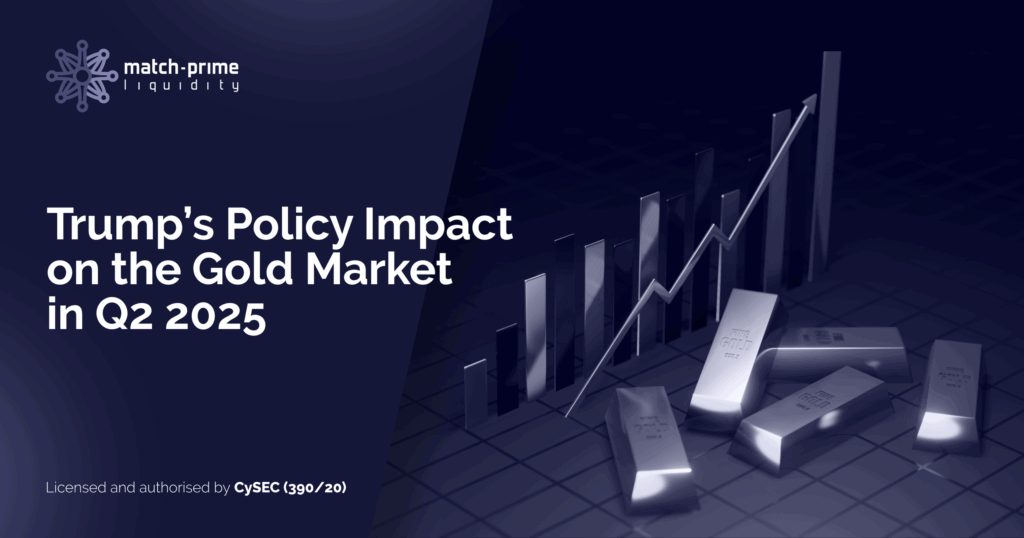In January and February 2025, the gold market experienced significant turbulence, driven by concerns over the unpredictable trade policy of the Trump administration. Announcements of potential tariffs—possibly extending to precious metals such as gold—triggered sharp investor reactions, impacting market mechanisms, including swap points and volatility. Although these events occurred several months ago, their repercussions, manifested as heightened volatility, continue to influence the market, necessitating close attention from market participants.

Gold Market Chaos
The upheaval in the gold market in the first quarter of 2025 was fueled by fears of tariffs, prompting American investors to engage in a massive import of physical gold. Consequently, COMEX exchange inventories surged to levels not seen since the COVID-19 pandemic, and the price differential between the active gold futures contract in the United States and the spot price reached $40–50 per ounce, compared to a two-year average of $13 per ounce. This unprecedented demand constrained the supply of gold available for lending, particularly in trading hubs like London, where unallocated gold inventories dropped to critically low levels.
A pivotal outcome of this phenomenon was a sharp rise in gold lease rates, which represent the cost of borrowing gold in the market. At the start of January 2025, the one-month gold lease rate stood at a mere 0.08% on an annualised basis. By January 20, it had climbed to 3.25%, peaking at 5% in February. This surge directly influenced swap points, which, in gold trading (e.g., on the XAU/USD pair), reflect the difference in financing costs between gold and the U.S. dollar.
XAU/USD Swap Points Reversal
The mechanism of swap points hinges on the interest rate differential between the two assets in a currency pair. For XAU/USD, gold does not generate interest, which traditionally results in negative swap points for long positions (buying gold against USD) and positive swap points for short positions (selling gold). However, in January 2025, the dramatic increase in gold lease rates, effectively acting as the “interest rate” for gold, surpassed the financing cost of USD. As a result, swap points for long positions approached zero and, in some cases, turned positive—an unprecedented situation, as traders, who typically incurred costs for holding long positions, began receiving positive swaps. Conversely, swap points for short positions, usually positive, became significantly negative, reaching as low as -80 USD in extreme cases.
This reversal was a direct consequence of the constrained supply of gold for lending, which inflated leasing costs and disrupted the traditional dynamics of swaps. Stabilisation began in late February as demand for physical gold subsided and inventories in trading hubs started to recover. Consequently, gold lease rates dropped to approximately 1%, restoring balance to financing costs. Swap points reverted to their typical pattern: negative for long positions and positive for short positions. This normalisation stemmed from both an improved supply of gold and adjustments in brokers’ swap policies, who responded to the altered market conditions to mitigate risks and reinstate standard mechanisms.
Gold Market Volatility Spikes in Q2 2025
While swap points have returned to normal, the gold market continues to grapple with elevated uncertainty, driven by Trump’s unpredictable trade policy. Price volatility in gold, measured by the CBOE Gold Volatility Index (GVZ), has reached levels unseen in years. The GVZ, often referred to as the “fear index” for gold (akin to the VIX for the S&P 500), reflects expected price volatility based on options prices for the SPDR Gold Shares (GLD) ETF. Higher GVZ values indicate greater anticipated price fluctuations, typically associated with geopolitical or macroeconomic uncertainty.
From late March to the end of April 2025, the GVZ surged from approximately 16 points to 28 points, marking its highest level since the outbreak of the Ukraine war in 2022. This is also one of the highest readings in the index’s history, with the GVZ exceeding 28 points only during major crises: 2008 (global financial crisis), 2011 (Eurozone debt crisis), 2013 (concerns over Fed tapering), 2020 (COVID-19 pandemic) and the aforementioned 2022. The current spike in volatility is directly linked to the destabilising decisions of the Trump administration, which continue to unsettle financial markets.
The elevated volatility signaled by the GVZ has significant implications for gold market participants, particularly brokers and financial institutions. Greater price fluctuations can lead to reduced market liquidity, especially during periods of heightened uncertainty. In such conditions, bid-ask spreads may widen, increasing transaction costs for traders and posing challenges for brokers in managing client positions.
2025 Gold Market Challenges
The turbulence in the gold market in the first quarter of 2025, triggered by Trump’s chaotic trade policy, exposed the market’s sensitivity to abrupt geopolitical and macroeconomic shifts. The reversal of swap points, driven by a sharp rise in gold lease rates, was a transient but unexpected phenomenon. Although swap mechanisms have normalised due to stabilised gold supply and declining lease rates, the current high volatility, as measured by the GVZ, underscores persistent uncertainty. Amid unpredictable U.S. administration decisions, the financial sector must remain vigilant, proactively managing risks and closely monitoring dynamic market changes.


